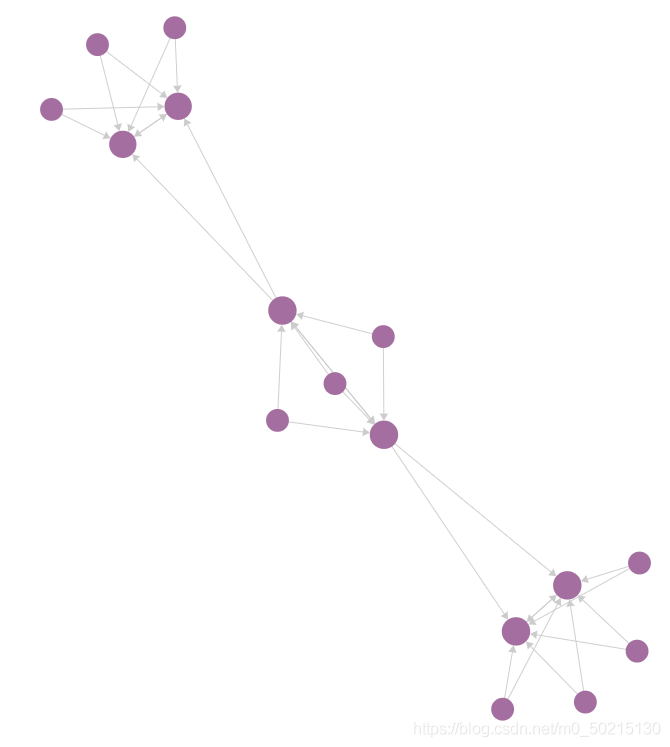目录
内文
一、目标:
二、输入:
三、执行:
四、输出:
五、参考:
内文
一、目标:
从csv档汇入Graph Db(Neo4j、ArangoDB、OrientDB)Couple
二、输入:
PERSON-资料
Relationships (parent,spouse) -关系
三、执行:
Neo4j
query
POST /db/data/transaction/commit(默认数据库),/db/mydb/tx/commit
{
"statements" :
[
{
"statement" : "match (n:PERSON {ID:$Id})-[r:PARENT|SPOUSE *..3] -(x) return * limit 100",
"parameters" : {
"nodeId" : "${id}"
},
"resultDataContents" : [ "row", "graph" ]
}
]
}
import
"bin/neo4j-admin import \
--nodes=import/node_a--relationships=import/rel_a \
--relationships
=import/rel_b \
--skip-bad-relationships=true \
--skip-duplicate-nodes=true \
--database= mydb"
ArangoDB
查询
POST /_api/cursor
{
"query" : "FOR n IN PERSON FILTER n.ID=='${id}' FOR v, e, p IN 1..3 ANY n GRAPH myGraph LIMIT 100 RETURN p ",
"count" : true
}
导入节点
bin/arangoimp --file "/path/file.csv" \
--type csv \
--collection "NODE" \
--server.username user \
--server.password pwd \
--translate "_ID:ID=_key" \
--translate ":TYPE=type" \
--separator=","
导入边
bin/arangoimp - -file "/path/rel_file.csv" \
--type csv \
--collection "EDGE" \
--server.username user \
--server.password pwd \
--separator="," \
--translate ": START_ID=_from" \
--translate ":END_ID=_to" \
--translate ":TYPE=type" \
--translate "LABEL=desc" \
--from-collection-prefix NODE \
--to-collection-prefix NODE \
--ignore-missing true
OrientDB
查询
GET /query/mydb/sql/
SELECT FROM (TRAVERSE in(),out() FROM (SELECT FROM PERSON WHERE ID='$id') MAXDEPTH 3)
导入节点
{
"source ": { "file": { "path": "/path/node.csv" } },
"extractor": { "csv": {} },
"transformers": [
{ "vertex": { "class" : "NODE" } }
],
"loader": {
"orientdb": {
"dbURL": "plocal:/path/databases/db",
"dbUser": "Admin",
"dbPassword": "xxxx",
" dbAutoCreate": true,
"dbType": "graph",
"classes": [
{"name": "NODE", "extends": "V"},
{"name": "EDGE", "extends": " E"}
], "indexes": [
{"class":"PERSON", "fields":["_ID_ID:string"], "type":"UNIQUE" }
]
}
}
}
导入边
{
"source": {“文件”:{“路径”:“/path/edge.csv”}},
“提取器”:{“cs v": {} },
"transformers": [
{ "merge": { "joinFieldName": "_START_ID", "lookup": "V._ID_ID", "unresolvedLinkAction": "SKIP" } },
{ "vertex" : { "class": "NODE", "skipDuplicates": true } },
{ "edge": {
"class": "EDGE",
"joinFieldName": "_END_ID",
"lookup": "V._ID_ID",
"direction": "out"
}
}
],
"loader": {
"orientdb": {
"dbURL": "plocal:/path/databases/db",
"dbUser": "Admin",
"dbPassword": "xxxx ",
"dbAutoCreate": true,
"dbType": "graph",
"classes": [
{"name": "NODE", "extends": "V"},
{"name": "EDGE", "extends ": "E"}
], "indexes": [
{"class":"NODE", "fields":["_ID_ID:string"], "type":"UNIQUE" }
]
}
}
}
ArangoDB需要
在shell中模式才能建立较复杂的图,
汇入csv 时需需要关系要与节点的对应关系,
可以转移栏位名称
OrientDB
使用ETL模式汇入数据
四、输出:
neo4j

arangodb

orientdb

五、参考:
https:/ /www.arangodb.com/docs/stable/programs-arangoimport-examples-csv.html
https://www.arangodb.com/docs/stable/graphs-general-graphs.html
https://www.arangodb.com /2020/05/best-practices-for-aql-graph-queries/
https://neo4j.com/docs/operat ions-manual/current/tools/neo4j-admin-import/
https://neo4j.com/docs/operations-manual/current/tutorial/neo4j-admin-import/
https://neo4j.com/docs/http- api/current/actions/begin-a-transaction/
http://orientdb.org/docs/3.0.x/etl/Loader.html
https://orientdb.org/docs/3.1.x/misc/OrientDB-REST .html
https://stackoverflow.com/questions/33679571/how-to-use-orientdb-etl-to-create-edges-only
————————————————
版权声明:本文为CSDN博主「Jpx23」的原创文章,遵循CC 4.0 BY-SA版权协议,转载请附上原文出处链接及本声明。
原文链接:https://blog.csdn.net/m0_50215130/article/details/118219270
